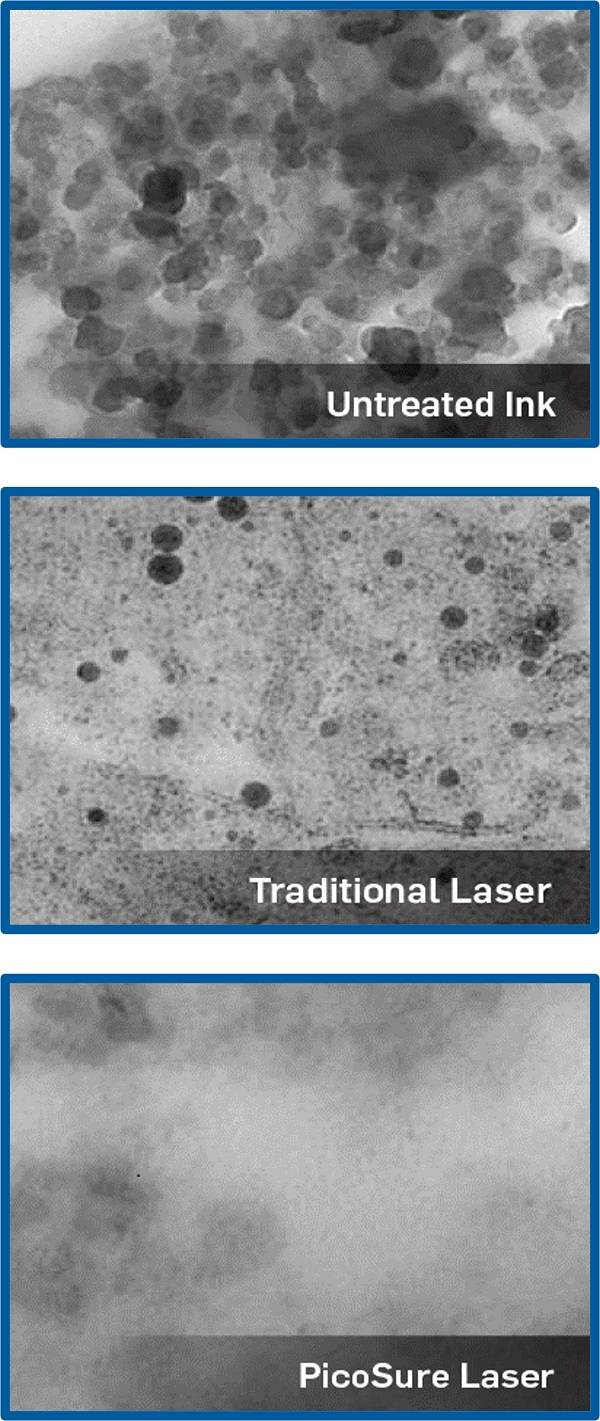
How PicoSure is Different
The PicoSure laser generates strong pulses of energy that hit the ink particle with a powerful pressure shock wave. This shatters the ink into tiny dust-like particles that are more rapidly eliminated by the body. And it accomplishes this without generating any heat in the tissue.

PicoSure vs. Conventional Lasers
Before the advanced technology of PicoSure, Q-Switched nano-lasers were considered the gold standard for removing tattoos. Unlike PicoSure, the slower Q-Switched lasers use thermal energy to heat up and break down ink into smaller particles. When using thermal energy to break apart ink particles, the process is limited to a medium reduction in size. Excessive heat can also contribute to scars and de-pigmentation.
Pico-Second vs. Nano-Second Lasers

When an engineer designs a laser, one of the options they must consider is the number of the pulses of laser light per second they want the device to emit. In general, the faster the laser emits pulses of coherent energy the more power (measured in watts) it will have. The nano-second laser emits a pulse every billionth of the second while the pico-second laser emits a pulse every trillionth of the second (1,000 times faster).
Nanosecond lasers predominantly rely on photo-thermal action, delivering heat to the pigment and surrounding tissue. The Picosecond technology works with the photo-mechanical (shock-wave) effect and has the ability to precisely target and destroy the melanin or tattoo inks of all colors, without affecting the surrounding tissue.
PicoSure can be successful in treating dark, hard to clear green and blue inks, sunset colors, such as pink, red, orange and yellow, as well as previously-treated, stubborn tattoos that did not respond well to other lasers. Another advantage that PicoSure has over other lasers is its ability to treat ALL skin types. Regardless of the ethnicity of our patients, a safe, effective treatment plan can be designed for everyone.
Older lasers, such as the Q-switched YAG, deliver pulses of light that are absorbed by the pigment in such a way that causes heat. Heat causes inflammation, pain, blisters, changes in the background pigment of our skin, and potentially scars. The Pressure Shock-wave that the PicoSure® laser produces is more effective and literally shatters the ink particles, without generating heat. Using the analogy that tattoo ink is a collection of rocks, the Q-switched lasers break the rocks into pebbles — the PicoSure laser smashes the rocks into sand.

The image on the left is a high-power, microscopic view of tattoo ink in the dermis layer of skin. The particles are large and cannot be transported away by the lymphatic system. Think of these particles as rocks.
The image in the middle is a high-power, microscopic view of tattoo ink that has been treated with a nano-second laser. The particles are fewer in number; however, several medium-size pieces remain in the dermis. Think of these particles as pebbles.
The image on the right is a high-power, microscopic view of tattoo ink that has been treated with a PicoSure laser. The pulses, delivered in one-trillionth of a second intervals, blasted the tattoo ink into very tiny pieces. Think of these particles as sand.
At one-thousand times faster than traditional nano-second technology, the PicoSure laser out-performs its competition. The tiny fragments of tattoo ink can be more efficiently cleared by the lymphatic system.
THE TECHNOLOGY
ABOUT DR. WETHERINGTON

Dr. Wetherington is certified by the American Board of Plastic Surgery. He is a member of the American Society for Aesthetic Plastic Surgery and the American Society of Plastic Surgeons. He is a former President of the Georgia Society of Plastic Surgeons.

PicoSure vs. Conventional Lasers
Before the advanced technology of PicoSure, Q-Switched nano-lasers were considered the gold standard for removing tattoos. Unlike PicoSure, the slower Q-Switched lasers use thermal energy to heat up and break down ink into smaller particles. When using thermal energy to break apart ink particles, the process is limited to a medium reduction in size. Excessive heat can also contribute to scars and de-pigmentation.
Pico-Second vs. Nano-Second Lasers

When an engineer designs a laser, one of the options they must consider is the number of the pulses of laser light per second they want the device to emit. In general, the faster the laser emits pulses of coherent energy the more power (measured in watts) it will have. The nano-second laser emits a pulse every billionth of the second while the pico-second laser emits a pulse every trillionth of the second (1,000 times faster).
Nanosecond lasers predominantly rely on photo-thermal action, delivering heat to the pigment and surrounding tissue. The Picosecond technology works with the photo-mechanical (shock-wave) effect and has the ability to precisely target and destroy the melanin or tattoo inks of all colors, without affecting the surrounding tissue.
PicoSure can be successful in treating dark, hard to clear green and blue inks, sunset colors, such as pink, red, orange and yellow, as well as previously-treated, stubborn tattoos that did not respond well to other lasers. Another advantage that PicoSure has over other lasers is its ability to treat ALL skin types. Regardless of the ethnicity of our patients, a safe, effective treatment plan can be designed for everyone.
Older lasers, such as the Q-switched YAG, deliver pulses of light that are absorbed by the pigment in such a way that causes heat. Heat causes inflammation, pain, blisters, changes in the background pigment of our skin, and potentially scars. The Pressure Shock-wave that the PicoSure® laser produces is more effective and literally shatters the ink particles, without generating heat. Using the analogy that tattoo ink is a collection of rocks, the Q-switched lasers break the rocks into pebbles — the PicoSure laser smashes the rocks into sand.

The image on the top is a high-power, microscopic view of tattoo ink in the dermis layer of skin. The particles are large and cannot be transported away by the lymphatic system. Think of these particles as rocks.
The image in the middle is a high-power, microscopic view of tattoo ink that has been treated with a nano-second laser. The particles are fewer in number; however, several medium-size pieces remain in the dermis. Think of these particles as pebbles.
The image on the bottom is a high-power, microscopic view of tattoo ink that has been treated with a PicoSure laser. The pulses, delivered in one-trillionth of a second intervals, blasted the tattoo ink into very tiny pieces. Think of these particles as sand.
At one-thousand times faster than traditional nano-second technology, the PicoSure laser out-performs its competition. The tiny fragments of tattoo ink can be more efficiently cleared by the lymphatic system.
THE TECHNOLOGY
ABOUT DR. WETHERINGTON

Dr. Wetherington is certified by the American Board of Plastic Surgery. He is a member of the American Society for Aesthetic Plastic Surgery and the American Society of Plastic Surgeons. He is a former President of the Georgia Society of Plastic Surgeons.


